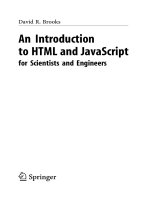AN INTRODUCTION TO MQTT, A PROTOCOL FOR M2M AND IoT APPLICATIONS
Bạn đang xem bản rút gọn của tài liệu. Xem và tải ngay bản đầy đủ của tài liệu tại đây (1.06 MB, 33 trang )
MQTT – MQ Telemetry Transport
MQTT
indigoo.com
MQ TELEMETRY TRANSPORT
AN INTRODUCTION TO MQTT, A PROTOCOL FOR
M2M AND IoT APPLICATIONS
© Peter R. Egli 2016
Peter R. Egli
INDIGOO.COM
1/33
Rev. 1.90
MQTT – MQ Telemetry Transport
indigoo.com
Contents
1.
2.
3.
4.
5.
6.
7.
8.
9.
10.
11.
12.
What is MQTT?
MQTT characteristics
Origins and future of MQTT standard
MQTT model
MQTT message format
MQTT QoS
CONNECT and SUBSCRIBE message sequence
PUBLISH message flows
Keep alive timer, breath of live with PINGREQ
MQTT will message
Topic wildcards
MQTT-S
© Peter R. Egli 2016
2/33
Rev. 1.90
MQTT – MQ Telemetry Transport
indigoo.com
1. What is MQTT?
MQTT is a lightweight message queueing and transport protocol.
MQTT, as its name implies, is suited for the transport of telemetry data (sensor and actor data).
MQTT is very lightweight and thus suited for M2M (Mobile to Mobile), WSN (Wireless Sensor
Networks) and ultimately IoT (Internet of Things) scenarios where sensor and actor nodes
communicate with applications through the MQTT message broker.
Example:
Light sensor continuously sends
sensor data to the broker.
Building control application
receives sensor data
from the broker and
decides to activate
the blinds.
Application sends a blind
activation message to
the blind actor node
through the broker.
© Peter R. Egli 2016
TCP/IP based
network (wired, wireless)
App
App
Sensor
Node
App
MQTT
Broker
Application
App
Actor
Node
3/33
Rev. 1.90
MQTT – MQ Telemetry Transport
indigoo.com
2. MQTT characteristics
MQTT Key features:
• Lightweight message queueing and transport protocol
• Asynchronous communication model with messages (events)
• Low overhead (2 bytes header) for low network bandwidth applications
• Publish / Subscribe (PubSub) model
• Decoupling of data producer (publisher) and data consumer (subscriber) through topics
(message queues)
• Simple protocol, aimed at low complexity, low power and low footprint implementations (e.g.
WSN - Wireless Sensor Networks)
• Runs on connection-oriented transport (TCP). To be used in conjunction with 6LoWPAN
(TCP header compression)
• MQTT caters for (wireless) network disruptions
Subscriber
Publisher
Broker
4
1
4
Topic
1
Topic
2
2
Subscriber
1
2
Publisher
3
Topic
© Peter R. Egli 2016
3
Subscriber
4/33
Rev. 1.90
MQTT – MQ Telemetry Transport
indigoo.com
3. Origins and future of MQTT standard
The past, present and future of MQTT:
MQTT was initially developed by IBM and Eurotech.
The previous protocol version 3.1 was made available under />
In 2014, MQTT was adopted and published as an official standard by OASIS (published V3.1.1).
As such, OASIS has become the new home for the development of MQTT.
The OASIS TC (Technical Committee) is tasked with the further development of MQTT.
Version 3.1.1 of MQTT is backward compatible with 3.1 and brought only minor changes:
• Changes restricted to the CONNECT message
• Clarification of version 3.1 (mostly editorial changes)
MQTT
V3.1
© Peter R. Egli 2016
MQTT
V3.1.1
5/33
Rev. 1.90
MQTT – MQ Telemetry Transport
indigoo.com
4. MQTT model (1/3)
The core elements of MQTT are clients, servers (=brokers), sessions, subscriptions and topics.
Application
(e.g. temp.
sensors)
MQTT
Server (= broker)
MQTT
Client
(=publisher,
Subscriber)
TCP/IP
Message
Message
MQTT Session
TCP Connection
Client
Subscriptions
Topic
A
Topic
B
Topic
C
TCP/IP
TCP/IP
Network
© Peter R. Egli 2016
6/33
Rev. 1.90
MQTT – MQ Telemetry Transport
indigoo.com
4. MQTT model (2/3)
MQTT client (=publisher, subscriber):
Clients subscribe to topics to publish and receive messages.
Thus subscriber and publisher are special roles of a client.
Client
Publisher
Subscriber
MQTT server (=broker):
Servers run topics, i.e. receive subscriptions from clients on topics, receive messages from
clients and forward these, based on client’s subscriptions, to interested clients.
Topic:
Technically, topics are message queues. Topics support the publish/subscribe pattern for
clients.
Logically, topics allow clients to exchange information with defined semantics.
Example topic: Temperature sensor data of a building.
Publisher
© Peter R. Egli 2016
Topic
Subscriber
7/33
Rev. 1.90
MQTT – MQ Telemetry Transport
indigoo.com
4. MQTT model (3/3)
Session:
A session identifies a (possibly temporary) attachment of a client to a server. All
communication between client and server takes place as part of a session.
Subscription:
Unlike sessions, a subscription logically attaches a client to a topic. When subscribed to a
topic, a client can exchange messages with a topic.
Subscriptions can be «transient» or «durable», depending on the clean session flag in the
CONNECT message:
«Transient» subscription ends with session:
Messages M3 and M4 are not received by the client
M1
M2
M3
Subscription
Create
M4
M5
M1
M2
M3
Subscription
Close
Create
Close
Create
Session
Create
M6
«Durable» subscription:
Messages M2, M4 and M5 are not lost but will be received by
the client as soon as it creates / opens a new session.
M5
M6
Subscription
Close
Create
Close
Create
Close
Session
Session
M4
Close
Session
Create
Close
Session
Create
Close
Message:
Messages are the units of data exchange between topic clients.
MQTT is agnostic to the internal structure of messages.
© Peter R. Egli 2016
8/33
Rev. 1.90
MQTT – MQ Telemetry Transport
indigoo.com
5. MQTT message format (1/14)
Message format:
MQTT messages contain a mandatory fixed-length header (2 bytes) and an optional messagespecific variable length header and message payload.
Optional fields usually complicate protocol processing.
However, MQTT is optimized for bandwidth constrained and unreliable networks (typically
wireless networks), so optional fields are used to reduce data transmissions as much as
possible.
MQTT uses network byte and bit ordering.
Field length
(bits)
Byte 1
Byte 2
0
1
2
Message Type
3
4
5
DUP
6
QoS Level
Remaining Length (1 – 4 bytes)
7
RETAIN
MQTT fixed
header
Byte 3
Optional: Variable Length Header
Byte n
Byte n+1
Optional: Variable Length Message Payload
Byte m
© Peter R. Egli 2016
9/33
Rev. 1.90
MQTT – MQ Telemetry Transport
indigoo.com
5. MQTT message format (2/14)
Overview of fixed header fields:
Message fixed header field
Description / Values
Message Type
0: Reserved
8: SUBSCRIBE
1: CONNECT
9: SUBACK
2: CONNACK
10: UNSUBSCRIBE
3: PUBLISH
11: UNSUBACK
4: PUBACK
12: PINGREQ
5: PUBREC
13: PINGRESP
6: PUBREL
14: DISCONNECT
7: PUBCOMP
15: Reserved
DUP
Duplicate message flag. Indicates to the receiver that this message may have already been received.
1: Client or server (broker) re-delivers a PUBLISH, PUBREL, SUBSCRIBE or UNSUBSCRIBE message
(duplicate message).
QoS Level
Indicates the level of delivery assurance of a PUBLISH message.
0: At-most-once delivery, no guarantees, «Fire and Forget».
1: At-least-once delivery, acknowledged delivery.
2: Exactly-once delivery.
Further details see MQTT QoS.
RETAIN
1: Instructs the server to retain the last received PUBLISH message and deliver it as a first message to new
subscriptions.
Further details see RETAIN (keep last message).
Remaining Length
Indicates the number of remaining bytes in the message, i.e. the length of the (optional) variable length header
and (optional) payload.
Further details see Remaining length (RL).
© Peter R. Egli 2016
10/33
Rev. 1.90
MQTT – MQ Telemetry Transport
indigoo.com
5. MQTT message format (3/14)
RETAIN (keep last message):
RETAIN=1 in a PUBLISH message instructs the server to keep the message for this topic.
When a new client subscribes to the topic, the server sends the retained message.
Typical application scenarios:
Clients publish only changes in data, so subscribers receive the last known good value.
Example:
Subscribers receive last known temperature value from the temperature data topic.
RETAIN=1 indicates to subscriber B that the message may have been published some time ago.
Publisher
PUBLISH, RETAIN=1
1
Data= 78ºC
Subscriber A
Server
Topic
Temp.
2
5
© Peter R. Egli 2016
Subscriber B
PUBLISH, RETAIN=1
Data= 78ºC
3
SUBSCRIBE
4
SUBACK
PUBLISH, RETAIN=1
Data= 78ºC
11/33
Rev. 1.90
MQTT – MQ Telemetry Transport
indigoo.com
5. MQTT message format (4/14)
Remaining length (RL):
The remaining length field encodes the sum of the lengths of:
a. (Optional) variable length header
b. (Optional) payload
To save bits, remaining length is a variable length field with 1…4 bytes.
The most significant bit of a length field byte has the meaning «continuation bit» (CB). If more
bytes follow, it is set to 1.
Remaining length is encoded as a * 1280 + b * 1281 + c * 1282 + d * 1283 and placed into the RL
field bytes as follows:
CB0
a
Byte 0 = LSB (a * 1280, CB0=1 if b > 0)
CB1
b
Byte 1 (b * 1281, CB1=1 if c > 0)
CB2
c
Byte 2 (c *
0
d
Byte 3 = MSB (d * 1283)
1282,
CB2=1 if d > 0)
Key:
LSB:
MSB:
Least Significant Byte
Most Significant Byte
Example 1: RL = 364 = 108*1280+2*1281 a=108, CB0=1, b=2, CB1=0, c=0, d=0, CB2=0
Example 2: RL = 25’897 = 41*1280 + 74*1281 + 1*1282 a=41, CB0=1, b=74, CB1=1, c=1, CB2=0, d=0
© Peter R. Egli 2016
12/33
Rev. 1.90
MQTT – MQ Telemetry Transport
indigoo.com
5. MQTT message format (5/14)
CONNECT message format:
The CONNECT message contains many session-related information as optional header fields.
Field length
(bits)
0
Byte 1
1
2
4
Message Type = 1
Byte 2
-
6
-
7
-
MQTT fixed
header
Protocol name UTF-8 encoded (e.g. «Light_Protocol»),
prefixed with 2 bytes string length (MSB first)
Byte n
Protocol version (value 0x03 for MQTT version 3)
Username
Flag
Password
Flag
Will
Retain
Will
QoS
Byte n+2
Keep Alive Timer MSB
Byte n+3
Keep Alive Timer LSB
Byte n+4
5
Remaining Length
Byte 3
Byte n+1
3
Will
Flag
Clean
Session
Reserved
MQTT variable
header
Client Identifier
Will Topic
Will Message
Optional
payload
Username
Byte m
© Peter R. Egli 2016
Password
13/33
Rev. 1.90
MQTT – MQ Telemetry Transport
indigoo.com
5. MQTT message format (6/14)
Overview CONNECT message fields:
CONNECT message field
Description / Values
Protocol Name
UTF-8 encoded protocol name string.
Example: «Light_Protocol»
Protocol Version
Value 3 for MQTT V3.
Username Flag
If set to 1 indicates that payload contains a username.
Password Flag
If set to 1 indicates that payload contains a password.
If username flag is set, password flag and password must be set as well.
Will Retain
If set to 1 indicates to server that it should retain a Will message for the client which is published in case the
client disconnects unexpectedly.
Will QoS
Specifies the QoS level for a Will message.
Will Flag
Indicates that the message contains a Will message in the payload along with Will retain and Will QoS flags.
More details see MQTT will message.
Clean Session
If set to 1, the server discards any previous information about the (re)-connecting client (clean new session).
If set to 0, the server keeps the subscriptions of a disconnecting client including storing QoS level 1 and 2
messages for this client. When the client reconnects, the server publishes the stored messages to the client.
Keep Alive Timer
Used by the server to detect broken connections to the client.
More details see Keepalive timer.
Client Identifier
The client identifier (between 1 and 23 characters)uniquely identifies the client to the server. The client
identifier must be unique across all clients connecting to a server.
Will Topic
Will topic to which a will message is published if the will flag is set.
Will Message
Will message to be puslished if will flag is set.
Username and Password
Username and password if the corresponding flags are set.
© Peter R. Egli 2016
14/33
Rev. 1.90
MQTT – MQ Telemetry Transport
indigoo.com
5. MQTT message format (7/14)
CONNACK message format:
Field length
(bits)
0
Byte 1
1
2
3
Message Type = 2
4
-
Byte 2
Remaining Length = 2
Byte 3
Reserved (not used)
Byte 4
Connect Return Code
CONNACK message field
Description / Values
Reserved
Reserved field for future use.
Connect Return Code
0:
1:
2:
3:
4:
5:
6-255:
© Peter R. Egli 2016
5
6
-
7
-
MQTT fixed
header
MQTT variable
header
Connection Accepted
Connection Refused, reason = unacceptable protocol version
Connection Refused, reason = identifier rejected
Connection Refused, reason = server unavailable
Connection Refused, reason = bad user name or password
Connection Refused, reason = not authorized
Reserved for future use
15/33
Rev. 1.90
MQTT – MQ Telemetry Transport
indigoo.com
5. MQTT message format (8/14)
PUBLISH message format:
Field length
(bits)
0
Byte 1
1
2
3
Message Type = 3
Byte 2
4
DUP
5
6
QoS Level
7
RETAIN
Remaining Length
Byte 3
Topic Name String Length (MSB)
Byte 4
Topic Name String Length (LSB)
MQTT fixed
header
Byte 5
Topic Name
Byte n
Byte n+1
Message ID (MSB)
Byte n+2
Message ID (LSB)
MQTT variable
header
Byte n+3
Publish Message
Payload
Byte m
PUBLISH message field
Description / Values
Topic Name with Topic Name
String Length
Name of topic to which the message is published. The first 2 bytes of the topic name field indicate the topic
name string length.
Message ID
A message ID is present if QoS is 1 (At-least-once delivery, acknowledged delivery) or 2 (Exactly-once
delivery).
Publish Message
Message as an array of bytes. The structure of the publish message is application-specific.
© Peter R. Egli 2016
16/33
Rev. 1.90
MQTT – MQ Telemetry Transport
indigoo.com
5. MQTT message format (9/14)
PUBACK message format:
Field length
(bits)
0
Byte 1
1
2
3
Message Type = 4
4
5
-
Byte 2
Remaining Length = 2
Byte 3
Message ID (MSB)
Byte 4
Message ID (LSB)
6
-
7
-
MQTT fixed
header
MQTT variable
header
PUBACK message field
Description / Values
Message ID
The message ID of the PUBLISH message to be acknowledged.
PUBREC message format:
Field length
(bits)
Byte 1
0
1
2
Message Type = 5
3
4
5
-
Byte 2
Remaining Length = 2
Byte 3
Message ID (MSB)
Byte 4
Message ID (LSB)
PUBREC message field
Description / Values
Message ID
The message ID of the PUBLISH message to be acknowledged.
© Peter R. Egli 2016
6
-
7
-
MQTT fixed
header
MQTT variable
header
17/33
Rev. 1.90
MQTT – MQ Telemetry Transport
indigoo.com
5. MQTT message format (10/14)
PUBREL message format:
Field length
(bits)
0
Byte 1
1
2
3
Message Type = 6
4
DUP
Byte 2
Remaining Length = 2
Byte 3
Message ID (MSB)
Byte 4
Message ID (LSB)
5
6
7
QoS Level
-
MQTT fixed
header
MQTT variable
header
PUBREL message field
Description / Values
Message ID
The message ID of the PUBLISH message to be acknowledged.
PUBCOMP message format:
Field length
(bits)
0
Byte 1
1
2
Message Type = 7
3
4
5
-
Byte 2
Remaining Length = 2
Byte 3
Message ID (MSB)
Byte 4
Message ID (LSB)
PUBCOMP message field
Description / Values
Message ID
The message ID of the PUBLISH message to be acknowledged.
© Peter R. Egli 2016
6
-
7
-
MQTT fixed
header
MQTT variable
header
18/33
Rev. 1.90
MQTT – MQ Telemetry Transport
indigoo.com
5. MQTT message format (11/14)
SUBSCRIBE message format:
Field length
(bits)
0
Byte 1
1
2
3
4
Message Type = 8
Byte 2
DUP
5
6
7
QoS Level
-
Remaining Length
Byte 3
Message ID (MSB)
Byte 4
Message ID (LSB)
Byte 5
Topic Name String Length (MSB)
Byte 6
Topic Name String Length (LSB)
MQTT fixed
header
MQTT variable
header
Byte 7
List of topics
Topic Name
Byte n
Reserved (not used)
QoS Level
SUBSCRIBE message field
Description / Values
Message ID
The message ID field is used for acknowledgment of the SUBSCRIBE message since these have a QoS level of
1.
Topic Name with Topic Name
String Length
Name of topic to which the client subscribes. The first 2 bytes of the topic name field indicate the topic name
string length.
Topic name strings can contain wildcard characters as explained under Topic wildcards.
Multiple topic names along with their requested QoS level may appear in a SUBSCRIBE message.
QoS Level
QoS level at which the clients wants to receive messages from the given topic.
© Peter R. Egli 2016
19/33
Rev. 1.90
MQTT – MQ Telemetry Transport
indigoo.com
5. MQTT message format (12/14)
SUBACK message format:
Field length
(bits)
Byte 1
0
1
2
3
Message Type = 9
Byte 2
4
5
-
6
-
7
-
Remaining Length
Byte 3
Message ID (MSB)
Byte 4
Message ID (LSB)
MQTT variable
header
Byte 5
Reserved (not used)
Byte 6
Reserved (not used)
Granted QoS Level
Topic 1
Granted QoS Level
Topic 2
Reserved (not used)
Granted QoS Level
Topic m
Byte 7
Byte n
SUBACK message field
Description / Values
Message ID
Message ID of the SUBSCRIBE message to be acknowledged.
Granted QoS Level for Topic
List of granted QoS levels for the topics list from the SUBSCRIBE message.
© Peter R. Egli 2016
MQTT fixed
header
List of granted
topic QoS
levels
20/33
Rev. 1.90
MQTT – MQ Telemetry Transport
indigoo.com
5. MQTT message format (13/14)
UNSUBSCRIBE message format:
Field length
(bits)
0
Byte 1
1
2
3
Message Type = 10
Byte 2
4
DUP
5
6
7
QoS Level
-
Remaining Length
Byte 3
Message ID (MSB)
Byte 4
Message ID (LSB)
Byte 5
Topic Name String Length (MSB)
Byte 6
Topic Name String Length (LSB)
Byte 7
MQTT fixed
header
MQTT variable
header
List of topics
Topic Name
Byte n
UNSUBSCRIBE message
field
Description / Values
Message ID
The message ID field is used for acknowledgment of the UNSUBSCRIBE message (UNSUBSCRIBE messages
have a QoS level of 1).
Topic Name with Topic Name
String Length
Name of topic from which the client wants to unsubscribe. The first 2 bytes of the topic name field indicate the
topic name string length.
Topic name strings can contain wildcard characters as explained under Topic wildcards.
Multiple topic names may appear in an UNSUBSCRIBE message.
© Peter R. Egli 2016
21/33
Rev. 1.90
MQTT – MQ Telemetry Transport
indigoo.com
5. MQTT message format (14/14)
UNSUBACK message format:
Field length
(bits)
0
Byte 1
1
2
3
Message Type = 11
4
5
-
Byte 2
Remaining Length = 2
Byte 3
Message ID (MSB)
Byte 4
Message ID (LSB)
6
-
7
-
MQTT fixed
header
MQTT variable
header
UNSUBACK message field
Description / Values
Message ID
The message ID of the UNSUBSCRIBE message to be acknowledged.
DISCONNECT, PINGREQ, PINGRESP message formats:
Field length
(bits)
Byte 1
Byte 2
© Peter R. Egli 2016
0
1
2
Message Type
3
4
Remaining Length = 0
5
6
-
7
-
MQTT fixed
header
22/33
Rev. 1.90
MQTT – MQ Telemetry Transport
indigoo.com
6. MQTT QoS (1/2)
MQTT provides the typical delivery quality of service (QoS) levels of message oriented
middleware.
Even though TCP/IP provides guaranteed data delivery, data loss can still occur if a TCP
connection breaks down and messages in transit are lost.
Therefore MQTT adds 3 quality of service levels on top of TCP.
Increasing level
of QoS
QoS level 2
Exactly-once delivery
QoS level 1
At-least-once delivery
QoS level 0
At-most-once delivery (=best effort)
QoS level of
network (TCP/IP)
Best effort
QoS level 0:
At-most-once delivery («best effort»).
Messages are delivered according to the delivery guarantees of the underlying network
(TCP/IP).
Example application: Temperature sensor data which is regularly published. Loss of an
individual value is not critical since applications (consumers of the data) will anyway integrate
the values over time and loss of individual samples is not relevant.
© Peter R. Egli 2016
23/33
Rev. 1.90
MQTT – MQ Telemetry Transport
indigoo.com
6. MQTT QoS (2/2)
QoS level 1:
At-lest-once delivery. Messages are guaranteed to arrive, but there may be duplicates.
Example application: A door sensor senses the door state. It is important that door state
changes (closedopen, openclosed) are published losslessly to subscribers (e.g. alarming
function). Applications simply discard duplicate messages by evaluating the message ID field.
QoS level 2:
Exactly-once delivery.
This is the highest level that also incurs most overhead in terms of control messages and the
need for locally storing the messages.
Exactly-once is a combination of at-least-once and at-most-once delivery guarantee.
Example application: Applications where duplicate events could lead to incorrect actions, e.g.
sounding an alarm as a reaction to an event received by a message.
© Peter R. Egli 2016
24/33
Rev. 1.90
MQTT – MQ Telemetry Transport
indigoo.com
7. CONNECT and SUBSCRIBE message sequence (1/2)
Case 1: Session and subscription setup with clean session flag = 1 («transient» subscription)
Client
Server
1
TCP connection setup
2
CONNECT, clean session = 1
Session lifetime
3
CONNACK
4
SUBSCRIBE, topic=XYZ
Session is created with
CONNECT message
Subscription lifetime
© Peter R. Egli 2016
5
SUBACK
6
PUBLISH, receive messages
to / from topic
7
UNSUBSCRIBE, topic=XYZ
8
UNSUBACK
9
DISCONNECT
Subscription ends
with UNSUBSCRIBE
DISCONNECT terminates
the session
25/33
Rev. 1.90









